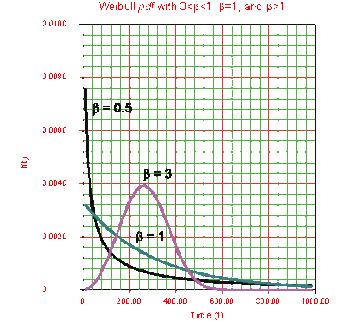Template:The effect of beta on the Weibull pdf: Difference between revisions
Jump to navigation
Jump to search
No edit summary |
No edit summary |
||
| Line 7: | Line 7: | ||
For <math> 0<\beta \leq 1 </math>: | For <math> 0<\beta \leq 1 </math>: | ||
:*As <span class="texhtml">'' | :*As <span class="texhtml">''t''→0</span> <span class="texhtml">(</span>or <span class="texhtml">γ),</span> <span class="texhtml">''f''(''T'')→∞.</span> | ||
:*As <span class="texhtml">''T''→∞</span>, <span class="texhtml">''f''('' | :*As <span class="texhtml">''T''→∞</span>, <span class="texhtml">''f''(''t'')→0</span>. | ||
:*<span class="texhtml">''f''('' | :*<span class="texhtml">''f''(''t'')</span> decreases monotonically and is convex as increases beyond the value of <span class="texhtml">γ</span>. | ||
:*The mode is non-existent. | :*The mode is non-existent. | ||
For <span class="texhtml">β > 1</span>: | For <span class="texhtml">β > 1</span>: | ||
:*<span class="texhtml">''f''('' | :*<span class="texhtml">''f''(''t'') = 0</span> at <span class="texhtml">(</span>or <span class="texhtml">γ)</span>. | ||
:*<span class="texhtml">''f''('' | :*<span class="texhtml">''f''(''t'')</span> increases as <math> t\rightarrow \tilde{T} </math> (the mode) and decreases thereafter. | ||
:*For <span class="texhtml">β < 2.6</span> the Weibull <math>pdf</math> is positively skewed (has a right tail), for <span class="texhtml">2.6 < β < 3.7</span> its coefficient of skewness approaches zero (no tail). Consequently, it may approximate the normal <math>pdf</math> , and for <span class="texhtml">β > 3.7</span> it is negatively skewed (left tail). The way the value of <span class="texhtml">β</span> relates to the physical behavior of the items being modeled becomes more apparent when we observe how its different values affect the reliability and failure rate functions. Note that for <span class="texhtml">β = 0.999</span>, <span class="texhtml">''f''(0) = ∞</span>, but for <span class="texhtml">β = 1.001</span>, <span class="texhtml">''f''(0) = 0.</span> This abrupt shift is what complicates MLE estimation when <span class="texhtml">β</span> is close to one. | :*For <span class="texhtml">β < 2.6</span> the Weibull <math>pdf</math> is positively skewed (has a right tail), for <span class="texhtml">2.6 < β < 3.7</span> its coefficient of skewness approaches zero (no tail). Consequently, it may approximate the normal <math>pdf</math> , and for <span class="texhtml">β > 3.7</span> it is negatively skewed (left tail). The way the value of <span class="texhtml">β</span> relates to the physical behavior of the items being modeled becomes more apparent when we observe how its different values affect the reliability and failure rate functions. Note that for <span class="texhtml">β = 0.999</span>, <span class="texhtml">''f''(0) = ∞</span>, but for <span class="texhtml">β = 1.001</span>, <span class="texhtml">''f''(0) = 0.</span> This abrupt shift is what complicates MLE estimation when <span class="texhtml">β</span> is close to one. | ||
Revision as of 21:46, 9 February 2012
The Effect of β on the [math]\displaystyle{ pdf }[/math]
Figure 6-1 shows the effect of different values of the shape parameter, β, on the shape of the [math]\displaystyle{ pdf }[/math]. One can see that the shape of the can take on a variety of forms based on the value of β.
For [math]\displaystyle{ 0\lt \beta \leq 1 }[/math]:
- As t→0 (or γ), f(T)→∞.
- As T→∞, f(t)→0.
- f(t) decreases monotonically and is convex as increases beyond the value of γ.
- The mode is non-existent.
For β > 1:
- f(t) = 0 at (or γ).
- f(t) increases as [math]\displaystyle{ t\rightarrow \tilde{T} }[/math] (the mode) and decreases thereafter.
- For β < 2.6 the Weibull [math]\displaystyle{ pdf }[/math] is positively skewed (has a right tail), for 2.6 < β < 3.7 its coefficient of skewness approaches zero (no tail). Consequently, it may approximate the normal [math]\displaystyle{ pdf }[/math] , and for β > 3.7 it is negatively skewed (left tail). The way the value of β relates to the physical behavior of the items being modeled becomes more apparent when we observe how its different values affect the reliability and failure rate functions. Note that for β = 0.999, f(0) = ∞, but for β = 1.001, f(0) = 0. This abrupt shift is what complicates MLE estimation when β is close to one.
